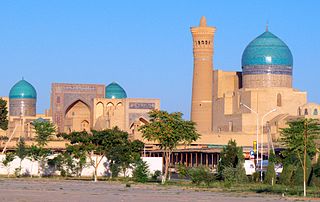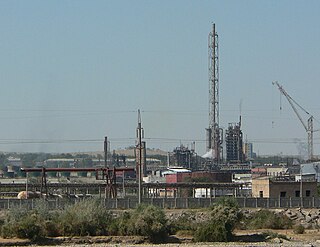
Tashkent or Toshkent, historically known as Chach, is the capital and largest city of Uzbekistan. It is the most populous city in Central Asia, with a population of 2,909,500 (2022). It is located in northeastern Uzbekistan, near the border with Kazakhstan. Tashkent comes from the Turkic tash and kent, literally translated as "Stone City" or "City of Stones".

Bukhara is the seventh-largest city in Uzbekistan, with a population of 280,187 as of 1 January 2020, and the capital of Bukhara Region.

The Registan was the heart of the ancient city of Samarkand of the Timurid Empire, now in Uzbekistan. The name Rēgistan (ریگستان) means "sandy place" or "desert" in Persian.

Termez is the capital of Surxondaryo Region in southern Uzbekistan. Administratively, it is a district-level city. Its population is 182,800 (2021). It is notable as the site of Alexander the Great's city Alexandria on the Oxus, as a center of Early Buddhism, as a site of Muslim pilgrimage, and as a base of Soviet Union military operations in Afghanistan, accessible via the nearby Hairatan border crossing.

Shah-i-Zinda is a necropolis in the north-eastern part of Samarkand, Uzbekistan.

Makhdoom Yahiya Maneri was an Indian Sufi saint of the 13th century. His tomb in courtyard of a mosque, located in Maner, 29 km from Patna, Bihar, India.

Chirchiq, also spelled as Chirchik, is a district-level city in Tashkent Region, Uzbekistan. It is about 32 km northeast of Tashkent, along the river Chirchiq. Chirchiq lies in the Chatkal Mountains. The population of Chirchiq as of 2021 is approximately 162,800.
Today, the museums of Uzbekistan store over two million artifacts, evidence of the unique historical, cultural, and spiritual life of the Central Asian peoples that have lived in the region.

Sheihantaur, the mausoleum of Sheikh Hovendi at-Tahur, is an architectural monument in Tashkent, Uzbekistan.

Bogʻiston, also written as Bagistan, is a village located in the Boʻstonliq District of the Tashkent Region of Uzbekistan. It lies at the southeast of the Charvak Reservoir at 960 m a.s.l. of western extremity of the Koksu Ridge. Practically Bog-i Ston nestles among verdure ashore the river Pskem where it flows into the Charvak Reservoir. "Bog-i Ston" is Tajik for "Land of orchards".
The city of Multan, Punjab, Pakistan has many mausoleums and shrines, due to its rich heritage of pirs and saints. Some of the best-known mausoleums that can still be visited today include the following.

Saif ed-Din Bokharzi & Bayan-Quli Khan Mausoleums are mausoleums dedicated to Saif ed-Din Bokharzi, a Khorasani sheikh, and Bayan-Quli Khan, the Chagatay ruler. They are located in the settlement called Fathabad, to the east from medieval Bukhara, in the past was situated vast religious complex. The initial core of the complex was the grave of Saif ed-Din al-Boharsi. The followers of the sheikh al-Boharsi have built up at this area of rabad many dormitories (khanakas) for dervishes, who lived there on donations of the Kubrawiya Sufi order members. The Fathabad settlement later had joined the city. The Chagatay ruler Bayan-Quli Khan had expressed a wish to be interred near by respected burial place of al-Boharsi, and it is there that he is buried. In 1358, the Mausoleum of Bayan-Quli Khan had appeared there.

Sheikh Rukn-ud-Din Abul Fateh was an eminent Punjabi Sufi saint from Multan in modern-day Pakistan who belonged to Suhrawardiyya Sufi order. He is commonly known by the title (Shah) Rukn-e-Alam.
Ak Astana-Baba is a 10th-11th century mausoleum that is located in the Sariosiyo District, Surxondaryo Region of Uzbekistan. The mausoleum was submitted to the UNESCO World Heritage Tentative List on June 1, 1996, in the Cultural category.
The Sheikh Mukhtar-Vali Complex is a mausoleum located 5 km southwest of the town of Yangiariq, Xorazm Region, Uzbekistan. It was erected in the 16th century, above the grave of Sheikh Mukhtar-Vali.
Mir-Sayid Bakhrom Mausoleum is a 10th-11th century mausoleum in the city of Karmana near Navoiy, Uzbekistan. Mir-Sayid Bakhrom has features similar to the Samanid Mausoleum in Bukhara, Arab-Ata Mausoleum in the Samarkand Region, and to the mausoleum of Oq Ostona Bobo in the Surxondaryo Region.

National University of Uzbekistan (NUUz) is a public university located in Tashkent, Uzbekistan. NUUz is the oldest and largest university in Uzbekistan.

Mausoleum of Sheikh Juneyd – is located in Hazra village of Qusar Rayon. Hazra village is not far from Azerbaijan’s border with Dagestan. From history of battle period between the Shirvanshahs and Ardabil sheikhs it is known, that Shaykh Junayd - grandfather of Shah Ismail I – perished in the battlefield with Khalilullah’s army in 1456 and was buried there. Construction of the mausoleum on his grave was carried out significantly later. A ligature in the northern façade of the complex evidences about it. Investigation of the building shows that a part of the building, where the construction ligature is located now, has been attached to the building of the mausoleum later. Then it should be acknowledged that this ligature has been brought here from the main building during construction of the annex.

The Navoi Theater is the national opera theater in Tashkent, Uzbekistan.
The architecture of Uzbekistan is noted for its originality. Many consider Uzbekistan’s architecture to be notable despite the changing economic conditions, technological advances, demographic fluctuations, and cultural shifts that the country has experienced.


















